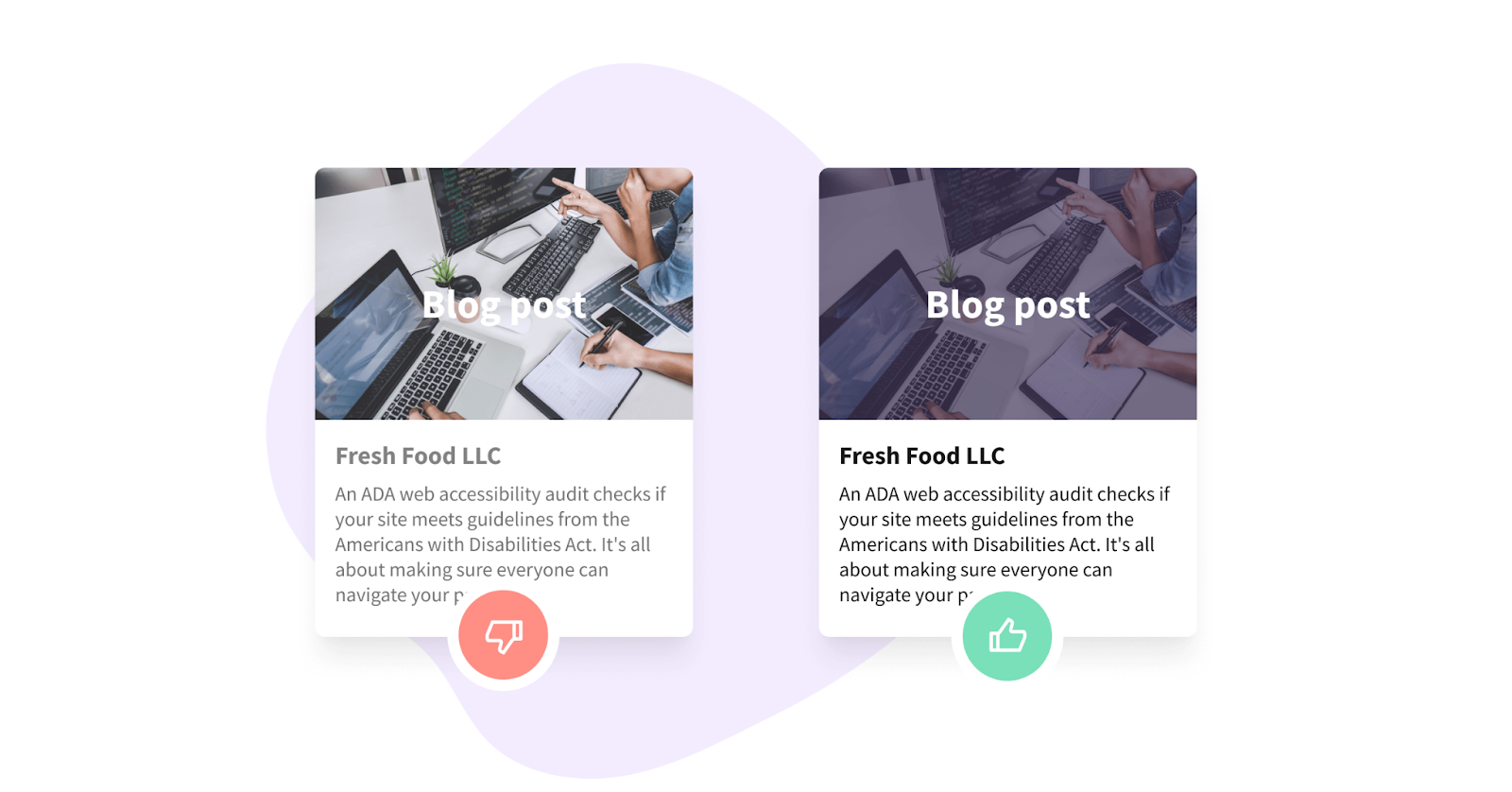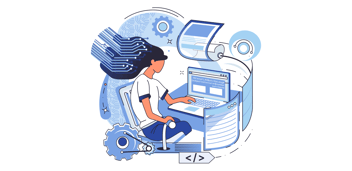Have you ever considered the insights an ADA website audit could provide by navigating a website with your eyes closed? Seems like an odd query, right?
But imagine the World Wide Web as a bustling city. The websites are buildings, their pages – different rooms and floors. Now, picture yourself blindfolded in this digital metropolis.
This is how millions of visually impaired individuals interact with the internet every day, underlining the importance of making a website accessible. And they rely on tools like screen readers to guide them through this intricate landscape.
An ADA website audit is much like providing a map for these users. But there’s more to it than just that…
To the forefront of accessibility. This journey will illuminate ADA audits’ intricacies in their automated processes and manual procedures. Each route has its own merits and challenges that we’ll delve into. In unraveling the complex tapestry of WCAG standards, we find an essential beacon guiding us toward making digital spaces more accessible for everyone.
Table Of Contents:
- Understanding ADA Website Audit
- Importance of ADA Website Compliance
- The Process of Conducting an ADA Website Audit
- Role of WCAG Standards in ADA Website Compliance
- Manual vs Automated ADA Website Audits
- Ensuring ADA Compliance in Website Design and Development
- FAQs about Ada Website Audit
- Conclusion

Understanding ADA Website Audit
An ADA website audit is a critical step every website owner should undertake to ensure web accessibility and foster inclusivity for all users, including those with disabilities. It’s not just about being kind; it is also a necessity to avoid legal action.
The process involves an in-depth evaluation of your digital assets using automated audits and manual testing. Automated tools quickly scan your site, identifying potential barriers based on the Web Content Accessibility Guidelines (WCAG). However, they can’t catch everything – hence the need for human expertise.
Automated Audits in ADA Compliance
Automated audits conducted by accessibility checkers like DePalma Studios test pages against WCAG standards at lightning speed. They’re fantastic at spotting missing alternative text or detecting inaccessible interactive elements – think buttons that screen readers can’t interpret.
The drawback? While fast and cost-effective, these audits may miss subtler issues tied to user experience—a major component of WCAG success criteria—that only human evaluators can identify effectively.
Manual Audits in ADA Compliance
Manual audits, meanwhile, tend to be more comprehensive but are typically more expensive due to the level of detail involved. These are performed by web accessibility experts who undertake a rigorous testing process across various devices and platforms while using assistive technologies such as screen readers.
In essence, manual tests give a deeper dive into possible compliance gaps—like understanding if PDF files are readable or whether complex data tables make sense when read aloud by assistive technology.
Undoubtedly, both types of audits play crucial roles in ensuring a website is genuinely accessible and ADA-compliant. The combination allows for a balance between breadth, depth, cost-effectiveness, and thoroughness – all vital aspects of accessibility testing.
Importance of ADA Website Compliance
Why should businesses pay attention to ADA website compliance? Companies should be aware of ADA website compliance for more than just meeting legal requirements; it’s about ensuring all users, including those with disabilities, can access digital content. Providing all users, including those with disabilities, have equal access to your digital assets is essential for ADA website compliance.
Web Content Accessibility Guidelines (WCAG), established by the Wide Web Consortium, serve as the gold standard for creating an accessible user experience. These guidelines offer success criteria that ensure interactive elements on your website provide equal access and opportunity to all users.
Failing to meet these accessibility standards can lead to potential lawsuits and missed business opportunities. If your site lacks alternative text for images or has PDF files inaccessible via screen readers, you’re effectively locking out millions of potential customers who use assistive technologies.
The Impact of Non-compliance on Businesses
In today’s competitive market landscape, every visitor counts. Inaccessible websites risk losing a significant portion of their audience due to a lack of ADA compliance – something no savvy business owner would want.
Risks Vs Benefits: A Closer Look at Automated Audits and Manual Testing
- Automated audits:
- – They’re fast but may miss some accessibility barriers because they primarily rely on algorithms rather than human judgment.
- Manual testing:
- – Although slower and usually more expensive, manual tests conducted by web accessibility experts offer thorough results uncovering hidden issues automated tools might skip over.
So, the question isn’t “Why should we make our website ADA compliant?” but rather “How soon can we start our ADA compliance audit?”.
The Process of Conducting an ADA Website Audit
An effective ADA website audit starts with an accessibility check by selecting a representative sample of web pages for testing. This helps to ensure that all aspects, including interactive elements and PDF files, are taken into account during the accessibility testing.
The first step is choosing a WCAG standard against which your site will be evaluated. Typically, we recommend aiming for at least level A or AA compliance under the Web Content Accessibility Guidelines (WCAG) 2.1 as they’re widely recognized standards by the World Wide Web Consortium (W3C).
Once you’ve selected your benchmark standard, it’s time to commence with both automated and manual tests on your chosen sample pages. Automated tools can quickly identify glaring issues, such as a lack of alternative text for images or other content that may present barriers to screen readers.
But remember this: automated audits aren’t enough on their own. They help flag potential problems but don’t provide the nuanced understanding necessary for full ADA compliance.
Necessity of Manual Audits in Testing
To make sure no stone is left unturned in checking website accessibility, human expertise comes into play here – yes, I’m talking about manual testing. Humans can pick up on context-based errors and understand user experience nuances better than any tool out there.

Auditors using assistive technologies like screen readers themselves check if digital assets align well with these aids used by many people who have disabilities. Manual checks also include looking at design components from an inclusivity perspective – how easy is it to navigate around? This is where experts who design websites with accessibility in mind become invaluable.
Maintaining Ongoing Compliance
Last but not least, ensuring ongoing compliance post-audit matters too. It’s essential to make sure your website is constantly following WCAG protocols and regulations. So, it isn’t just about passing an audit – you’ve got to maintain those high accessibility standards for the long haul.
Role of WCAG Standards in ADA Website Compliance
The World Wide Web Consortium’s (W3C) Web Content Accessibility Guidelines (WCAG) play a critical role in ADA website compliance. These guidelines set the standard for web accessibility, making sure that digital assets are usable by everyone, including people with disabilities.

Understanding WCAG 2.1 A or AA
To start with, let’s delve into the levels of conformance defined by these standards: Level A, Level AA, and Level AAA. While meeting all three would be ideal to ensure your site is fully accessible to all users – this isn’t always feasible due to technical constraints or specific design elements.
In most cases, achieving either level A or AA will suffice for businesses aiming at becoming more accessible and thus compliant with ADA laws. Why so? Well, because they cover the most common issues faced by disabled individuals while interacting online, such as providing alternative text for images lacking it, which can hinder user experience when using screen readers.
The WCAG success criteria are also evident on interactive elements like buttons and forms needing understandable instructions and labels, along with offering multiple ways to navigate through your website content – from headers over paragraphs right down to links within them.
Achieving these standards not only helps make your site inclusive but can protect you against potential legal implications related to non-compliance. This makes an ADA compliance audit, both automated testing methods and manual audits done by web accessibility experts, essential steps toward maintaining your website’s accessibility status.
Beyond simply avoiding lawsuits, though, lies another vital benefit – improving overall user experience across a wide range of audiences, ensuring no one gets left out in the digital world.
Manual vs. Automated ADA Website Audits
The debate between manual and automated ADA website audits is akin to the classic clash of man versus machine. Cutting through the clutter, what truly matters when assessing accessibility?
Automated Audits: The Speedy Sentry
Like a screen reader, an automated audit races through your digital assets at lightning speed. It uses computerized tools that follow WCAG guidelines to spot apparent issues like the lack of alternative text for images or interactive elements without accessible names. These audits are cost-effective and fast, but remember, they’re not foolproof.
Key stats show that while automated audits are quick on their feet, they might miss out on more complex problems that can affect user experience – especially for those using assistive technologies. Just think about it as having a robot check your car engine; it can spot any visible issues but might fail to detect nuanced problems.
Manual Audits: The Thorough Detective
In contrast, manual ADA website compliance testing brings human expertise into play where web accessibility experts use various devices and platforms for thorough evaluation based on success criteria defined by Web Content Accessibility Guidelines (WCAC).

Akin to an experienced detective inspecting every nook and cranny manually, these auditors leave no stone unturned – checking everything from PDF files’ readability with screen readers to tab navigation functionality across all pages. This approach takes more time than its automatic counterpart – almost similar to hand washing clothes versus using a washer.
We know, though, from our key stats that although expensive compared to an automated audit report- you get what you pay for because they offer much better results overall when addressing web accessibility barriers.
As a website proprietor, it’s critical to consider the pros and cons of both techniques to keep your webpage available for all visitors.
Ensuring ADA Compliance in Website Design and Development
Maintaining ADA compliance isn’t a one-time task but an ongoing effort. Web developers have a significant role in keeping ADA compliance current, from the initial design of the website to constant updates.
The first step is understanding WCAG standards. These guidelines provide a roadmap on how to design websites in an accessible manner from the get-go, including people with disabilities. For instance, WCAG success criteria require that all interactive elements have alternative text descriptions for screen readers – assistive technologies used by visually impaired users.
But merely knowing the rules isn’t enough; it’s equally important to implement them effectively during the development stage. That includes creating alternative paths for every interaction so no user feels left out because of their disability or lack of specific tech tools.
Continuous Efforts are Key
To ensure your website remains compliant over time, regular audits need to be conducted. Automated testing and manual audits help identify potential barriers preventing some visitors from fully experiencing your site content.
Audits include checking PDF files (common culprits regarding accessibility issues), validating color contrasts against WCAG guidelines, and even scrutinizing code structure itself. An audit report provides valuable insights into where improvements can be made.
Relying on Expertise Matters
If you’re unsure about tackling this task yourself or want professional guidance, web accessibility experts can do wonders here. They understand intricate details related to WCAG standards and common challenges businesses face trying to meet these requirements.
FAQs about Ada Website Audit

How do I audit a website for ADA?
To run an ADA website audit, use automated tools and manual testing. This combo lets you spot accessibility issues tied to WCAG standards.
What is the ADA website accessibility audit?
An ADA web accessibility audit checks if your site meets guidelines from the Americans with Disabilities Act. It’s all about making sure everyone can navigate your pages.
How do I check my ADA compliance for a website?
You verify your site’s ADA compliance by performing audits against WCAG standards. Automated tools help, but don’t skip manual reviews by human experts either.
What is the ADA standard audit?
The ‘ADA standard’ means meeting Web Content Accessibility Guidelines (WCAG). An audit tests if your site aligns with these requirements, keeping it open to all users.
Conclusion
Remember, an ADA website audit is like a map for your users. It’s about ensuring that everyone can navigate the digital landscape with ease.
The two main types of audits, automated and manual, have their strengths. Computerized audits are quick and cost-effective, while manual ones give more thorough results but take longer and might be pricier.
Above all else, strive to meet WCAG standards in the design and development stages. This ensures that you’re creating accessible websites right from the start!
Maintaining compliance isn’t just a one-time task—it requires continuous efforts as technologies evolve.
Let’s pull together and make our little slice of the web a welcoming spot for everyone by putting accessibility at the top of our to-do list! :rocket:






